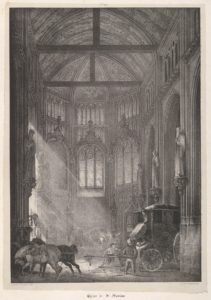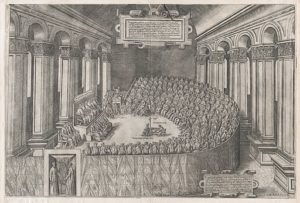by Susan L. Siegfried

Charles Thévenin, Prise de la Bastille, 1790. Metropolitan Museum of Art, New York.
The essay begins:
Anyone reflecting on the relation of the “image” to “history” in the eighteenth century, as I have been asked to do for this essay, must begin with Francis Haskell’s History and Its Images (1993), the major work on that subject. In a book of impressive scope and erudition, Haskell addressed an important problem: what is the impact of the visual arts on the historical imagination? His study, as he described it, explored “how, when, and why historians have tried to recapture the past, or at least a sense of the past, by adopting the infinitely seductive course of looking at the image that the past has left of itself.” He surveyed historians from Petrarch (1304–74) through Johan Huizinga (1872–1945) and examined how they used images as historical tools or as part of their historical method, addressing questions about the nature of visual evidence and the ground on which it is interpreted that such an investigation inevitably raised. Reading History and Its Images now, I am struck by two things. First is the dishearteningly negative verdict it passes on the consequence of images to historians; for all the authors he discusses, not one comes up to the mark of integrating images into narrative histories or of reckoning works of art as constitutive of history. Second is the surprisingly little impact History and Its Images has had within the field of art history, and in other disciplines for that matter, despite having been widely reviewed. A possible explanation may be that Haskell does not show why images mattered or how people engaged with them when they did. In keeping with his formation as a historian, he kept his sights firmly trained on major narratives written by professional historians such as Edward Gibbon’s The History of the Decline and Fall of the Roman Empire (1776–89). What Haskell’s study leaves out, though it does suggest, is the interest taken in visualizing history and in concretizing textual accounts of it through material remains of the past and images of them.
Narrative was only one form that an interest in history took in the eighteenth century. People’s engagement with artifacts, images of them, and images that envisioned past events and personalities was extremely important and part of what might be called a larger historical imaginary. This visual engagement with the past fed indirectly into serious historical narratives. Gibbon said he was inspired to write The History of the Decline and Fall of the Roman Empire by going to the Roman forum and seeing its extensive monumental architecture at first hand, even though no visual analysis or description of the ruins enters into his history. Haskell was so intent on pointing out the separation of visual experience and published histories, and on pointing out disparities between them, that he did not explore the power and draw of images and artifacts in their relation to a historical imaginary. Yet one could say that visual artifacts informed the period’s fervent interest in Roman antiquities and drew readers to Gibbon’s book. There was a subliminal relationship between images and texts, a give-and-take that makes visual representation difficult to separate from historical representation and also makes its agency difficult to define: visual experience played into an interest in history, just as knowledge of history prompted curiosity about material artifacts, events, and people of the past, but without a systematic connection between the visual and the textual.
This essay argues that an impulse to visualize history through prints, drawings, and paintings took hold during the eighteenth century, with consequences for the newly popular print media’s effect on conceptualizations of history that remain insistently elusive. It was as if history, which conventionally drew its authority from texts, needed a supporting network of images to bring one closer to the past and lend a reality to its accounts. Theories and concepts of history were never argued through images, but these “visual documents,” as one might call them, still seemed capable of bridging the gap between present and past. If the mounting accumulation of images that bore witness to history in the eighteenth century could be said to have exerted an influence on writing about historical processes and events, the French Revolution placed some in evidence. The Revolution was seen as the ultimate event produced by history up to that time. It changed history’s course, and its energies seem to have released visual images from the usual textual scaffolding that bore witness to events that were perceived as making history. This development implied that history, or at least a history of the Revolution, would need to, and have no choice but to, incorporate images in order to provide a complete record of events, though how far this view of visual testimony extended remains is, by its very nature, impossible to pin down.
Some basic questions about terms of reference might be posed at the outset. What conditions enabled an impulse to visualize history to develop during the eighteenth century and what forms did it take? Equally important, what was meant by “history” at the time? An interest in secular history was decidedly on the rise during this period, which expanded the possibilities for imagining the human’s relation to the world and to time. Sales and reviews of history books and geographies increased steadily relative to books of theology and jurisprudence, indicating inquisitiveness on the part of the reading public about those areas of knowledge. At the same time, visual images multiplied, especially in the form of prints but in other media as well. Every quantitative measure of material culture in the eighteenth century attests to continuing growth in the consumption and production of paintings, prints, drawings, illustrated books, illustrated journals, and decorative arts embellished with images, to say nothing of forms of visual spectacle and popular entertainment or of images produced from optical experiments in the natural sciences. This expansion of visual culture was especially marked during the second half of the century, when an increase in prosperity and education led to an increased demand for printed images of all sorts for educational, informational, and entertainment purposes. There were so many printed images in circulation that the age was sometimes called “the papered century” or, in Germany, Papierkultur.
An impulse to visualize the past during this period can be divided into roughly two modalities: an antiquarian impulse to collect artifacts and to document them visually in drawings and prints, on the one hand, and an imaginary impulse to recreate scenes or events of the past through illusionistic renderings of them, on the other. In what follows, I look at examples from both realms, beginning with the documentary mode. This primarily took the form of objects, including prints, assembled in private collections and occasionally published. Here I shall focus on those collectors specifically interested in historical subjects. I then move to the imaginary mode, which envisioned past events visually as stories with actions and actors. I consider illustrations that were integrated into history books as well as large-scale history paintings that detached their representations of subjects from any originary texts. In the final section of the essay, I return to the documentary mode to consider the role of printed images during the French Revolution as creators of instant history.
The term “history” was so broadly used in the eighteenth century that it can be confusing to readers today. It embraced everything from compilations of knowledge such as natural history to stories in the sense of “istoria” as defined in Giorgio Vasari’s sixteenth-century treatise on painting. The deceptive breadth of the concept is suggested by Antoine-Joseph Dezallier d’Argenville’s use of it in a long essay published in the Mercure de France in 1727. Dezallier (1680–1765), a royal administrator and lawyer, was an avid collector and writer on subjects ranging from gardening and natural history to the fine arts. In his essay, he advised collectors on how to organize a cabinet of curiosities, including sizeable collections of printed images. The publication of this essay in the Mercure attests to the rise of the private collector or connoisseur and the importance of connoisseurial knowledge as a social code of distinction and language of polite sociability. Regarding prints, Dezallier advised collectors to classify them by subject matter rather than by artist, contrary to the market’s preference for identification by author, and to place them under three broad categories: history, portraits, and landscapes. The prominence of histoire in this scheme is highly suggestive, but on closer inspection, Dezallier appears to have meant “history” in the traditional and benign sense of “story.” He divided the category into sacred and profane history, which was conventional enough, but then proceeded to correlate profane history with the artists Godfrey Kneller, John Closterman, Daniel Teniers, and Adriaen van Ostade. These were seventeenth-century painters of portraits and low-life genre scenes, and they strike us today as surprising choices to exemplify a category largely associated with political or diplomatic events or judicial transactions of the past, subjects those artists rarely, if ever, painted. What, then, did Dezallier mean by “history”? He certainly was not thinking of what we might consider social history or a history of changing customs or moeurs. The question becomes all the more insistent in light of Dezallier’s classification of subjects that we often regard as historical events—“marriages,” “funerals,” “entries,” “battles,” “sieges,” “army marches”—under the category of landscape, not under histoire. His classification scheme suggests that ceremonies were perceived as ahistorical, as transcending time by virtue of repeating ritual enactments of power, or alternatively as transpiring in space (like “landscape”) more than in time. In attempting to understand what he meant by “history,” it becomes relevant to consider his debt to a rhetorical mode of classifying the fine arts, a realm with which he was very familiar as an art collector and writer on art. In the fine arts, “history” encompassed anything with narrative; “portraits” referred to portrayals of individuals; and “landscape” embraced representations of the environment. His use of the term “history,” then, was period specific and inflected by practice and criticism within the realm of the fine arts. Continue reading …
In this essay Susan Siegfried explores an impulse to visualize history in eighteenth-century France. She focuses on massive compilations of printed images that assembled overviews of history as represented by artifacts, portraits, and events and compares that documentary mode of visualizing the past to imaginary reconstructions of historical events in illusionistic scenes as depicted in the radically different formats of book illustration and monumental history painting.
 SUSAN L. SIEGFRIED is Denise Riley Collegiate Professor of the History of Art and Women’s Studies at the University of Michigan. She is completing a book on visual representations of fashion and costume in nineteenth-century Europe.
SUSAN L. SIEGFRIED is Denise Riley Collegiate Professor of the History of Art and Women’s Studies at the University of Michigan. She is completing a book on visual representations of fashion and costume in nineteenth-century Europe.
 Théodore Géricault, Église de Saint-Nicolas, 1824, Metropolitan Museum, New York
Théodore Géricault, Église de Saint-Nicolas, 1824, Metropolitan Museum, New York ALLAN DOYLE is an art historian whose research focuses on the representation of history in nineteenth-century French art and visual culture. He is currently finishing a book on the afterlife of Michelangelo Buonarroti in French Romantic painting.
ALLAN DOYLE is an art historian whose research focuses on the representation of history in nineteenth-century French art and visual culture. He is currently finishing a book on the afterlife of Michelangelo Buonarroti in French Romantic painting.


 What happened when the most important genre of Renaissance painting, the historia (a “visual history”), built its images on scenes of eyewitnessed current events disseminated in the new medium of print? Is it a coincidence that a new claim to the eyewitnessing of current events in paint occurred in the fifteenth century, around the time that print made such palpably new histories available to a wide audience? While this essay will not undertake to prove that mechanical reproducibility put pressure on the historia to disseminate events as they appeared and as they happened, it will attempt to show the transformative encounter of these two things. A series of representations of a signal historical event enables us to see the convergence of the eyewitnessed image and print in action, and I propose to treat the meeting of the Council of Trent (1545–63) as my example, in part out of perversity. This event, which was in reality a visually uninteresting series of meetings (rows of people talking) spanning decades, was represented in a way that was both more textured and detailed than previous such scenes. And the long arc of time over which the council met was dealt with visually by representing what appears to be a single moment, a radical (and arbitrary) condensation in pictures—in a manner equivalent to the boiling down of a long war, with its many skirmishes, by representing a single moment in a single battle that in itself may have been of no particular significance. We will see, though, that a visual history that looks right to the eye in a given instant is still an image that has been put to work by specific agents. It was usually not sufficient merely to show a historical event; the artist had to make sense of it, to interpret it, to declare a position. The historia remained intact, and yet the eyewitnessed image, by virtue of its visual media, also had a stimulating effect as evidence-based history.
What happened when the most important genre of Renaissance painting, the historia (a “visual history”), built its images on scenes of eyewitnessed current events disseminated in the new medium of print? Is it a coincidence that a new claim to the eyewitnessing of current events in paint occurred in the fifteenth century, around the time that print made such palpably new histories available to a wide audience? While this essay will not undertake to prove that mechanical reproducibility put pressure on the historia to disseminate events as they appeared and as they happened, it will attempt to show the transformative encounter of these two things. A series of representations of a signal historical event enables us to see the convergence of the eyewitnessed image and print in action, and I propose to treat the meeting of the Council of Trent (1545–63) as my example, in part out of perversity. This event, which was in reality a visually uninteresting series of meetings (rows of people talking) spanning decades, was represented in a way that was both more textured and detailed than previous such scenes. And the long arc of time over which the council met was dealt with visually by representing what appears to be a single moment, a radical (and arbitrary) condensation in pictures—in a manner equivalent to the boiling down of a long war, with its many skirmishes, by representing a single moment in a single battle that in itself may have been of no particular significance. We will see, though, that a visual history that looks right to the eye in a given instant is still an image that has been put to work by specific agents. It was usually not sufficient merely to show a historical event; the artist had to make sense of it, to interpret it, to declare a position. The historia remained intact, and yet the eyewitnessed image, by virtue of its visual media, also had a stimulating effect as evidence-based history.  EVONNE LEVY
EVONNE LEVY